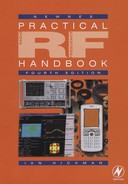SRDs (Short Range Devices)
A) SRDs in UK
1. This is a general term which is applied to various radio devices designed to operate over short ranges and at low power levels. This includes alarms, telemetry and telecommand devices, radio microphones, radio local area networks and antitheft devices, as well as certain microwave/doppler devices. A list of devices covered by this information sheet and the parameters that they must operate within can be found in the UK Radio Interface Requirement 2030. At the time of writing, this Radiocommunications Agency document is still available, but is under revision. Therefore no part of it is quoted, here: for more information visit: http://www.ofcom.org.uk.
2. Short range devices (SRD’s) are for terrestrial use only, unless stated otherwise. SRD’s normally operate on a non-protected, non-interference basis, see paragraphs under the heading Interference (paragraph 56 onwards).
Some points to note
3. When selecting parameters for new SRD’S, manufacturers and users should pay particular attention to the potential for interference from other systems operating in the same or adjacent bands. This is particularly important where a device may be used in a safety critical application.
4. SRD’s cannot claim protection from other authorised services and must not cause harmful interference.
5. It should be remembered that the pattern of radio use is not static. It is continuously evolving to reflect the many changes that are taking place in the radio environment; including the introduction of new applications and technologies. Spectrum allocations may need to be reviewed from time to time to reflect these changes and the position set out in the information sheet is subject to amendment following consultation with interested parties.
The following are examples of short range devices
• Alarm: An alarm system which uses radio signals to generate or indicate an alarm condition, or to arm or disarm the system.
• Radar Level Gauges: A device used mainly for measuring the contents of containers at industrial sites such as refineries. These devices operate in the microwave bands at low power levels.
• Radio Local Area Networks (RLANS): A radiocommunication device which links data networks/computers.
• Radio Microphone: A microphone that uses a radio link to convey speech or music to a remote receiver.
• Teleapproach: The use of radiocommunication for the purpose of gaining information as to the presence of any moving object. However, it is possible for the target to remain fixed whilst the source is mobile.
• Telecommand: The use of radiocommunication for the transmission of signals to initiate, modify or terminate functions of equipment at a distance.
• Telemetry: The use of radiocommunication for automatically indicating or recording measurements at a distance from the measuring instrument.
Licence exemption
When considering frequencies suitable for exemption Ofcom must take into account the difficulties involved in subsequent re-allocation of the spectrum. The problem arises due to the nature of unlicensed/exempt frequencies - i.e. no or very little data exists on its use (who, where, what, etc.) - which means that changing the designated use of the spectrum takes time and is difficult to do. Nevertheless Ofcom will continue to make exemption regulations wherever possible.
The ‘Short Range Devices Information Sheet’ RA 114 (Rev. 10) March 2003 can be viewed on the Ofcom website by entering ‘short range devices’ in the Search box and then following the links:
B) SRDs in Europe
SRDs thoroughout Europe come under ETSI rules, see www.etsi.org.
There is much interest in the European-wide development and application of SRDs, and particularly PULSERS - Pervasive Ultra-wideband Low Spectral Energy Radio Systems. See for example www.pulsers.info/pulsers1-pub-dir/PULSERS_White_Paper16.pdf
C) SRDs in the USA
Unlicensed short range devices in the USA come under FCC CFR Title 47, Part 15 rules (http://wireless.fcc.gov), details of which are available at http://www.access.gpo.gov/nara/cfr/waisidx_01/47cfr15_01.html
See also www.ieee802.org/16/le/docs80216h-05_015r1.pdf, where 802 standards are available for download, free of charge.
In 2004 the FCC released NPRM FCC-04-113 (Notice of Proposed Rulemaking), covering BWIA on unused TV channels (Broadband Wireless Internet Access), ET Docket 04-186. This, like PULSERS, is an example of the growing international interest in broadband systems.
